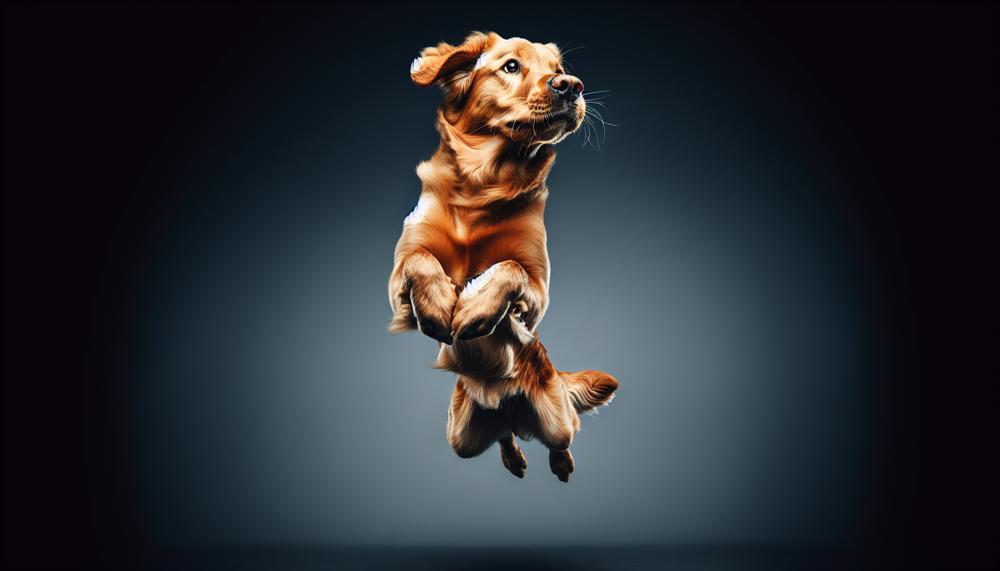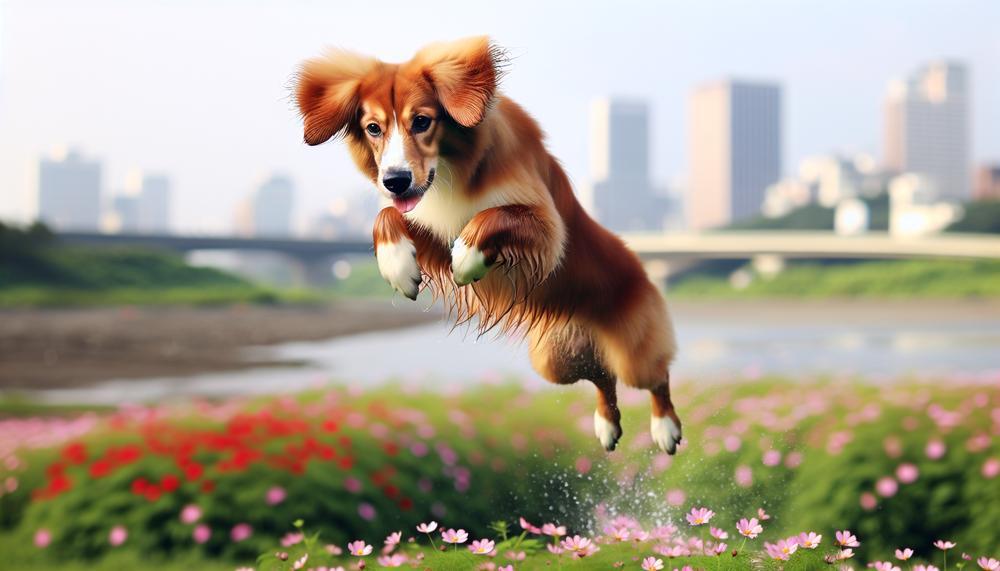Imagine strolling down the street with your beloved canine companion by your side. The sun is shining, birds are chirping, and everything seems perfect until suddenly, your dog jumps up on you with reckless abandon.
You try to regain your balance as they paw at your clothes, leaving muddy paw prints all over you. Does this sound like a familiar scenario?
If you’re a proud dog owner, chances are you’ve experienced this situation more times than you can count. But why do our furry friends have this seemingly uncontrollable urge to jump on us while we’re walking?
As it turns out, there are several reasons behind this behavior that may surprise you.
Let’s take a closer look at the psychology behind dogs jumping on their owners while walking:
- For many dogs, jumping is their way of showing affection and greeting.
- Some may be seeking attention or trying to get closer to their owner.
- In certain cases, jumping can be a sign of excitement or playfulness.
- However, for others, it may stem from anxiety or insecurity.
- Interestingly enough, this behavior can also be reinforced unintentionally by giving attention when the dog jumps.
Now that we have an understanding of why our furry friends engage in this behavior, let’s delve deeper into each point and explore some tips on how to manage it effectively.
Negative Behaviors During Dog Walks
Table of Contents

During dog walks, there are several negative behaviors that dogs commonly exhibit, such as pulling on the leash, jumping on people or other dogs, barking excessively, and trying to escape from the leash.
These behaviors can be effectively addressed by using positive reinforcement training techniques, ensuring proper exercise and regular walks, and understanding the root causes behind the behavior.
As a dog owner, it is crucial to maintain patience, consistency, and avoid any forms of punishment-based training methods in order to successfully tackle these negative behaviors.
Negative Behaviors During Dog Walks:
One of the most common negative behaviors during dog walks is when dogs pull on the leash. This not only makes it difficult for the owner to control the dog, but it can also lead to injuries for both the dog and the owner.
It is important to understand that dogs naturally have a strong instinct to explore their surroundings and may be excited during walks. However, this behavior can be addressed through positive reinforcement techniques such as rewarding the dog with treats when they walk calmly beside the owner without pulling on the leash.
Another negative behavior that is often seen during walks is when dogs jump on people or other dogs. This can be intimidating for others and can also lead to accidents or injuries. It is important for owners to train their dogs not to jump by consistently redirecting their attention to an appropriate behavior, such as sitting or staying still. Positive reinforcement techniques such as giving attention and praise when the dog displays desired behavior can also be effective.
Excessive barking during walks is another common issue that many dog owners face. Dogs may bark due to excitement, fear, or even boredom. It is important for owners to understand the reason behind their dog’s barking and address it accordingly. For example, if the dog is barking out of fear, it is important to work on building their confidence through positive reinforcement training instead of punishing them.
Lastly, some dogs may try to escape from the leash during walks. This can be a dangerous behavior as it puts the dog at risk of getting lost or injured. It is important for owners to ensure that their dog’s leash is secure and to work on training them to walk calmly without trying to escape.
Positive reinforcement techniques such as rewarding the dog with treats when they walk calmly beside the owner without trying to escape can help address this behavior.
Why Your Dog Jumps On You While Walking
This playful behavior can stem from a variety of reasons, including overstimulation, jealousy, anxiety, and lack of training and exercise. To address this behavior, it’s essential to understand the root cause and take appropriate steps to train and manage your dog’s behavior.
Understanding the Reasons Behind Jumping Behavior
There are several possible reasons why your dog may jump on you while walking.
- One possible explanation is their natural playfulness. Dogs often see jumping as a way to initiate play with their owners. Additionally, if your dog becomes overly excited during a walk, they may jump to release their pent-up energy.
- Another possible reason for jumping behavior is jealousy. If your dog sees you giving attention to someone else or another animal, they may jump in an attempt to regain your attention. Anxiety can also play a role in jumping behavior. Dogs may jump as a coping mechanism for feelings of fear or stress.
- Lack of training and exercise can also contribute to jumping behavior. Without proper training and adequate exercise, dogs may become unruly and jump as a way to release excess energy. And let’s not forget attention-seeking behavior – some dogs may jump simply to get attention from their owners.
Addressing Jumping Behavior
To effectively address jumping behavior, it’s crucial to establish consistent rules and boundaries through positive reinforcement training. This approach involves rewarding desired behaviors with treats or praise instead of using punishment. Punishment can have adverse effects on your dog’s well-being and may even worsen the jumping behavior.
Providing enough exercise for your dog is also essential in reducing jumping behavior. Regular walks and playtime can help release pent-up energy and prevent overstimulation during walks.
Understanding your dog’s triggers can also be helpful in addressing this behavior. If your dog jumps due to anxiety or jealousy, try to avoid those triggers or work on desensitizing them to those situations through positive reinforcement training.
The Daily Walk: Not Always Pure Joy
Here, we will explore the primary causes behind this behavior and provide tips on how to address it.
Understanding the Reasons Behind Jumping
Dogs are social creatures and jumping is a form of communication for them. They may bound up to seek attention, playfulness, or show excitement. In some cases, it can also be a sign of anxiety or frustration.
Understanding the root cause of your dog’s jumping behavior is crucial in addressing it effectively.
The Role of Training and Exercise
One of the main reasons why dogs jump while walking is a lack of training and exercise. Dogs need regular exercise to release their pent-up energy and prevent them from becoming bored or frustrated.
Additionally, proper training can help teach your dog appropriate behaviors and boundaries.
Positive Reinforcement Training
Positive reinforcement training is an incredibly effective way to address jumping behavior in dogs. This involves rewarding good behavior with treats or praise and ignoring negative behavior.
By consistently reinforcing good behavior, your dog will learn that jumping is not acceptable and will instead turn to more appropriate ways of seeking attention.
Identifying Triggers
It’s important to understand what triggers your dog’s jumping behavior. Is it when they see other dogs or people while walking? Or does it happen when they are feeling anxious or overwhelmed?
By identifying these triggers, you can work on desensitizing your dog and teaching them alternative behaviors.
Table: Common Reasons for Jumping Behavior in Dogs
| Reason | Description |
| Monotony | Dogs may leap out of monotony or lack of stimulation. |
| Attention-Seeking | Some dogs may jump to get their owner’s attention. |
| Overstimulation | Dogs may jump when feeling overstimulated or excited. |
| Lack of Training | Dogs who have not been trained properly may resort to jumping for attention. |
| Early Life | Puppies may jump as a form of playfulness, which can turn into a bad habit if not addressed. |
| Occasional Illness | In some instances, dogs may jump due to pain or discomfort. |
Conclusion
In conclusion, understanding the reasons behind our dogs’ tendency to jump on us while walking is crucial in effectively managing this behavior.
It could be a display of affection, excitement, or even anxiety – all of which may surprise us. However, with the use of positive reinforcement training methods and ensuring adequate exercise and regular walks, we can address this behavior in a way that benefits both our furry friends and ourselves.
Let’s not forget that jumping is a form of communication for dogs, and by identifying triggers and consistently reinforcing good behavior, we can help them learn appropriate ways to seek attention. Seeking advice from an expert in family dog training can also offer valuable insights into addressing jumping behavior while adding depth and value to the topic at hand.
So, next time your dog jumps on you during a walk, take a moment to carefully observe and analyze their behavior – it could be their way of communicating something important to you.






